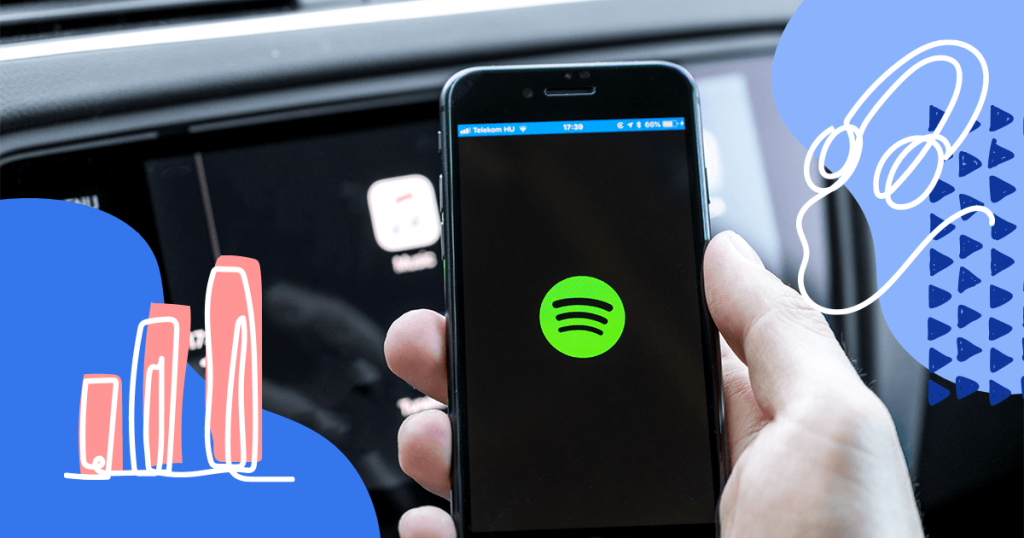These days, it’s no longer enough to simply do everything right when it comes to digital marketing.
Staying ahead of the game calls for an entirely new level of efficiency. Modern consumers are getting smarter and more discriminating, and your competition is working overtime to pull ahead of the pack.
Digital transformation is the key to creating intelligent, data-driven marketing campaigns that not only get your brand out there but have the power to move mountains.
As a brand that’s completely revolutionized the world of digital music and streaming media, Spotify is an excellent example of digital transformation done right.
You don’t have to be in the music business yourself to learn a lot by studying Spotify’s example, either.
Check out these key Spotify statistics for a closer look at precisely what Spotify’s doing right and how your business can do the same.
- 1. 365 million people use Spotify every month
- 2. Spotify hosts over 70 million songs and 2.9 million podcasts
- 3. 52% of user listening time happens through mobile devices
- 4. 1,000 Spotify artists generated over $1 million on the platform in 2021
- 5. In 2020, 90 million people engaged with the Spotify Wrapped feature
- 6. Since its creation, Spotify has only made a profit three times
- 7. Spotify controls around a third of the music streaming market share
1. 365 million people use Spotify every month
Not only do 365 million people use Spotify regularly — a minimum of once a month — but 165 million monthly Spotify users are paying members.
What’s more, those paid subscriber numbers reflect an 87 million-user jump from the same quarter of the previous year.
Spotify accomplished this by packaging itself as the must-have streaming platform for the Millennial and Gen Z markets.
It also presented itself as a solution those markets badly needed — a safe, convenient, and affordable alternative to pirated music.
Young users can do everything on Spotify that they used to be able to do on the old peer-to-peer file-sharing platforms but to a greater degree.
There’s more music to choose from, the quality is better, and the user experience is absolutely seamless.
That said, Spotify is an excellent lesson in identifying a market need no one else is really addressing, creating a product or service, and moving right into that space.
Subscriber-based Spotify statistics are also proof-positive that if you offer users enough value, they will decide to pay for the premium version of that service.
2. Spotify hosts over 70 million songs and 2.9 million podcasts
Spotify isn’t just a convenient place to go listen to music. It hosts over 70 million songs and 2.9 million podcasts.
There are very few options a user might go there looking for that they won’t be able to find. And Spotify offers such an eclectic mix of music options that it’s an incredible place to discover new music to love when you’re done replaying your old favorites for the umpteenth time.
The fact that they offer a free, ad-supported service in addition to several different paid plans (including one just for students) also helps the brand reach people who might be unable to afford a paid service or still be skeptical about trying one.
Spotify’s free tier is an important part of scaling their service and grooming their users to eventually upgrade to one of their paid options.
Modern businesses can look at Spotify statistics like these and see how to succeed with a business model that offers a little something for every member of its target audience.
Spotify is also a shining example of how to provide a balanced free version of a service — a version that’s useful enough to be a good option for those who truly can’t afford to pay but limited enough that those who enjoy it probably will choose to pay eventually.
3. 52% of user listening time happens through mobile devices
Mobile devices like smartphones and tablets aren’t secondary ways of accessing the internet for today’s consumers anymore.
They’re the preferred way by a landslide. This is no less the case for people who use the internet to listen to music or catch up with their favorite podcasts.
Although Spotify offers users a desktop app as an option, around 52 percent of user listening time is logged via smartphones and tablets — 10 percent on tablets and the remaining 42 percent on smartphones.
And those numbers are only going to rise as mobile devices become increasingly sophisticated and accessible.
The Spotify mobile app streamlines the experience even further for listening on the go.
Modern businesses that care about succeeding and staying relevant need to consider this when developing platforms, services, and marketing plans.
So definitely think about how you can make your company’s offerings mobile-friendly, at the very least. But a better idea would be to develop your product with the needs and preferences of mobile users in mind, just like Spotify has.
4. 1,000 Spotify artists generated over $1 million on the platform in 2021
Spotify isn’t just a platform for music lovers to listen to favorite artists and discover new ones to get into.
It’s also a place for artists to showcase their work, get discovered, and earn an income.
Although Spotify doesn’t boast the highest per-stream rates compared to other streaming music services, its popularity means successful artists are still pretty well taken care of.
According to Spotify itself, over 1,000 Spotify artists generated over $1 million on the platform in 2021.
However, many artists surpassed that mark. For instance, 450 artists generated over $2 million, while 130 artists surpassed the $5 million mark.
There are also more artists overall reaching all of the different revenue levels every year, with those rates climbing fast.
The above artist-related Spotify statistics aren’t the only examples of the incredible things that can happen when social platforms take care of their content providers. But they’re definitely among the most noteworthy.
Spotify works hard to help the artists who showcase their content there get found by people who’d love it. Any social business can learn a lot from how they do it.
5. In 2020, 90 million people engaged with the Spotify Wrapped feature
Today’s consumers want more than just a great service that makes their lives easier, simpler, or more fun.
They like feeling like they’re part of what the brands they buy from are doing, and offering great interactive content is a terrific way to do that.
For example, the Spotify Wrapped feature offers modern businesses a good look at what happens when you do interactive content right.
In 2020, more than 90 million people chose to engage with it, and even more elected to do the same in 2021.
That’s because this feature offers users so much more than just an interesting look at their listening habits and music discoveries over the course of the previous year.
It gives users an incredible opportunity to get to know themselves a little better through content offered by a service they love and use often.
Its annual December release has also made Spotify Wrapped an eagerly anticipated part of listeners’ end-of-year traditions, forming a powerful association between the Spotify brand and the special magic of the winter holidays.
It’s also a great example of how data-driven experiences can be used not only to improve the function of a business but to better engage users and show them how important they really are.
Spotify Wrapped is also a terrific example of personalized content in action.
6. Since its creation, Spotify has only made a profit three times
Many people make the mistake of thinking a platform as popular as Spotify has to have been seeing insane profits more or less since its launch.
However, in Spotify’s case, this just isn’t true. Spotify operated at a loss for many of the years following its launch in 2006.
In fact, Spotify has only turned a profit three times over the entire course of its history.
Hefty operating costs, especially those related to high licensing payments, had Spotify operating at a loss for a long time.
But the company was hesitant to hike subscription prices, which might have driven users to switch to alternatives like Apple Music or Amazon Music.
Instead, the streaming company looked for other ways to boost its bottom line — like enticing more users to subscribe by introducing cheaper plan tiers and cutting operating costs in other areas.
The lesson modern businesses can learn from revenue-related Spotify statistics is that a little creativity and innovation can work wonders for an ailing bottom line, especially if the overall model of a business is good.
The same goes for offering your customers more incentives to pay for your service or upgrade the plan they’re already using.
7. Spotify controls around a third of the music streaming market share
Before Spotify came along, the online music scene was very different.
The popularity of peer-to-peer file sharing interfaces like BitTorrent and Limewire showed that there was a demand for a platform that made discovering, listening to, and sharing music convenient and affordable.
And although options like iTunes and Pandora took some pretty big steps toward making that a reality, they never quite managed to replace piracy as the go-to option for music lovers.
On the other hand, Spotify took a promising business model and turned it into the new gold standard.
Spotify may not be the only streaming service in town anymore, but it remains the most popular, dominating 32,77% of the music streaming market share.
It also changed the music industry forever, as over 83% of music revenue in the United States now comes from streaming.
That said, Spotify is a great example of a brand that not only successfully identified a need but also improved upon previous industry attempts to fill it.
They did this well enough that it eventually changed the way consumers, musicians, and brands alike think of the music industry.
Does your brand have what it takes to dominate your industry the same way?
As you can see from the above Spotify statistics, this isn’t just any business we’re talking about here.
Spotify can teach marketers and business owners across any industry how to set, pursue, and achieve even the loftiest goals.
Specific platform features like Spotify Wrapped are also great examples of how gamification and interactivity can help brands get ahead.
Check out our comprehensive write-up on what Spotify Wrapped, in particular, can teach modern marketers about building better relationships with customers through great marketing.









